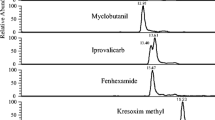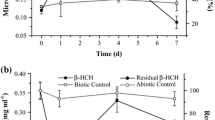Abstract
The hydrolysis and photolysis of the chiral fungicide mandipropamid were investigated, and the potential enantioselectivity of mandipropamid in solutions was further assessed. The aqueous solutions were filtered and directly injected into the liquid chromatography with tandem mass spectrometry. In the hydrolysis experiments, mandipropamid enantiomers hydrolyzed slowly in aquatic solutions with half-lives > 200 days; nevertheless, rise of the pH and incubation temperature could increase the hydrolysis rates more than 1.1 times (half-lives decreased from 495.1 to 216.6 days). Compared with the hydrolysis results, photolysis was found to be the main degradation pathway for mandipropamid in different solutions (half-lives < 14 h, except in pH = 5.05 buffer solution). Organic solvents were able to accelerate the photolysis of mandipropamid, but acidic solutions and the addition of flavonoids or inorganic salts significantly inhibited the photolysis of mandipropamid. During the hydrolysis and photolysis processes, the configuration of mandipropamid enantiomers was stable and five possible transformation products were identified by high resolution mass spectrometry. Due to the enantiomeric fraction values > 0.5, the hydrolysis and photolysis of mandipropamid were enantioselective, and S-( +)-mandipropamid preferentially disspated in certain aqueous solutions. The systematic evaluation of the hydrolysis and photolysis of mandipropamid enantiomers may provide more accurate data for better assessment of environmental and ecological risks in aquatic ecosystems.
Graphical abstract









Similar content being viewed by others
Data availability
All the relevant data generated and analyzed during this study are included in the article.
References
Allen LC (1989) Electronegativity is the average one-electron energy of the valence-shell electrons in ground-state free atoms. J Am Chem Soc 111:9003–9014
Al-Shaalanb NH, Ali I, Alothman ZA, Al-Wahaibi LH, Alabdulmonem H (2019) Enantioselective degradation of dufulin pesticide in water: uptake, thermodynamics, and kinetics studies. Chirality 31:1060–1069
Blum M, Boehler M, Randall E, Yong V, Csukai M, Kraus S, Moulin F, Scalliet G, Avrova AO, Whisson SC, Fonne-Pfister R (2010) Mandipropamid targets the cellulose synthase–like PiCesA3 to inhibit cell wall biosynthesis in the oomycete plant pathogen, Phytophthora infestans. Mol Plant Pathol 11:227–243
Buser HR, Müeller MD (1998) Occurrence and transformation reactions of chiral and achiral phenoxyalkanoic acid herbicides in lakes and rivers in Switzerland. Environ Sci Technol 32:626–633
Carrão DB, Perovani IS, de Albuquerque NCP, de Oliveira ARM (2020) Enantioseparation of pesticides: a critical review. TrAC Trends Anal Chem 122:115719
Di SS, Cang T, Qi PP, Wang XY, Xu MF, Wang ZW, Xu H, Wang Q, Wang XQ (2019) A systemic study of enantioselectivity of isocarbophos in rice cultivation: enantioselective bioactivity, toxicity, and environmental fate. J Hazard Mater 375:305–311
dos Louros VL, Silva CP, Nadais H, Otero M, Esteves VI, Lima DLD (2020) Photodegradation of sulfadiazine in different aquatic environments – evaluation of influencing factors. Environ Res 188:109730
Esmaeili H, Karami A, Maggi F (2018) Essential oil composition, total phenolic and flavonoids contents, and antioxidant activity of Oliveria decumbens Vent (Apiaceae) at different phenological stages. J Clean Prod 198:91–95
Fanigliulo A, Sacchetti M (2009) Mandipropamid: new fungicide against Phytophthora infestans on tomato. Acta Hortic 808:355–358
Fonseca FS, Carrão DB, de Albuquerque NCP, Nardini V, Dias LG, da Silva RM, Lopes NP, de Oliverira ARM (2019) Myclobutanil enantioselective risk assessment in humans through in vitro CYP450 reactions: metabolism and inhibition studies. Food Chem Toxicol 128:202–211
Gao BB, Zhang ZX, Li LS, Kaziem AE, He ZZ, Yang QW, Qing PY, Zhang Q, Wang MH (2019) Stereoselective environmental behavior and biological effect of the chiral organophosphorus insecticide isofenphos-methyl. Sci Total Environ 648:703–710
Garrison AW (2006) Probing the enantioselectivity of chiral pesticides. Environ Sci Technol 40:16–23
Gatidou G, Iatrou E (2011) Investigation of photodegradation and hydrolysis of selected substituted urea and organophosphate pesticides in water. Environ Sci Pollut Res 18:949–957
Habenschus MD, Nardini V, Dias LG, Rocha BA, Barbosa F Jr, de Oliveira ARM (2019) In vitro enantioselective study of the toxicokinetic effects of chiral fungicide tebuconazole in human liver microsomes. Ecotox Environ Safe 181:96–105
Hao WY, Hu X, Zhu FL, Chang J, Li JY, Li W, Wang HL, Guo BY, Li JZ, Xu P, Zhang YF (2018) Enantioselective distribution, degradation, and metabolite formation of myclobutanil and transcriptional responses of metabolic-related genes in rats. Environ Sci Technol 52:8830–8837
He RJ, Mai BL, Fan J, Jiang Y, Chen G, Guo D, Chen GD, Yao XS, Gao H, Zhang WG (2019) Identification, quantification, and stereoselective degradation of triazole fungicide cyproconazole in two matrixes through chiral liquid chromatography-tandem mass spectrometry. J Agric Food Chem 67:10782–10790
Hollman PCH, Arts ICW (2000) Flavonols, flavones and flavanols – nature, occurrence and dietary burden. J Sci Food Agric 80:1081–1093
Husain SR, Cillard J, Cillard P (1987) Hydroxyl radical scavenging activity of flavonoids. Phytochemistry 26:2489–2491
Jeschke P (2018) Current status of chirality in agrochemicals. Pest Manag Sci 74:2389–2404
JMPR (Joint FAO/WHO Meeting on Pesticide Residues) (2008) JMPR evaluation: mandipropamid. http://www.faoorg/fileadmin/templates/agphome/documents/Pests_Pesticides/JMPR/Evaluation08/Mandipropamidpdf. Accessed 5 January 2021
Kang YM, Kim MK, Zoh KD (2018) Effect of nitrate, carbonate/bicarbonate, humic acid, and H2O2 on the kinetics and degradation mechanism of bisphenol-A during UV photolysis. Chemosphere 204:148–155
Kaziem AE, Gao BB, Li LS, Zhang ZX, He ZZ, Wen Y, Wang MH (2020) Enantioselective bioactivity, toxicity, and degradation in different environmental mediums of chiral fungicide epoxiconazole. J Hazard Mater 386:121951
Koumaki E, Mamais D, Noutsopoulos C, Nika MC, Bletsou AA, Thomaidis NS, Eftaxias A, Stratogianni G (2015) Degradation of emerging contaminants from water under natural sunlight: the effect of season, pH, humic acids and nitrate and identification of photodegradation by-products. Chemosphere 138:675–681
Lv P, Min SY, Wang Y, Zheng XY, Wu XW, Li QX, Hua RM (2020) Flavonoid-sensitized photolysis of chlorothalonil in water. Pest Manag Sci 76:2972–2977
Mikami N, Imanishi K, Yamada H, Miyamoto J (1984) Photolysis and hydrolysis of the fungicide procymidone in water. J Pestic Sci 9:223–228
Nag SK, Dureja P (1997) Photodegradation of azole fungicide triadimefon. J Agric Food Chem 45:294–298
Oliveira C, Lima DLD, Silva CP, Calisto V, Otero M, Esteves VI (2019) Photodegradation of sulfamethoxazole in environmental samples: the role of pH, organic matter and salinity. Sci Total Environ 15:1403–1410
Pan XL, Cheng YP, Dong FS, Liu N, Xu J, Liu XG, Wu XH, Zheng YQ (2018) Stereoselective bioactivity, acute toxicity and dissipation in typical paddy soils of the chiral fungicide propiconazole. J Hazard Mater 359:194–202
Qi YL, Liu DH, Luo M, Jing X, Wang P, Zhou ZQ (2016) Enantioselective degradation and chiral stability of the herbicide fluazifop-butyl in soil and water. Chemosphere 146:315–322
Qu H, Ma RX, Liu DH, Gao J, Wang F, Zhou ZQ, Wang P (2016) Environmental behavior of the chiral insecticide fipronil: Enantioselective toxicity, distribution and transformation in aquatic ecosystem. Water Res 105:138–146
Schwack W, Hartmann M (1994) Fungicides and photochemistry: photodegradation of the azole fungicide penconazole. Z Lebensm Unters Forsch 198:11–14
Song SM, Zhang CF, Chen ZJ, Wei J, Tan HH, Li XS (2019) Hydrolysis and photolysis of bentazone in aqueous abiotic solutions and identification of its degradation products using quadrupole time-of-flight mass spectrometry. Environ Sci Pollut Res 26:10127–10135
Sun MJ, Liu DH, Zhou GX, Li JD, Qiu XX, Zhou ZQ, Wang P (2012) Enantioselective degradation and chiral stability of malathion in environmental samples. J Agric Food Chem 60:372–379
Tang XY, Cui ZG, Bai Y, Su RG (2021) Indirect photodegradation of sulfathiazole and sulfamerazine: influence of the CDOM components and seawater factors (salinity, pH, nitrate and bicarbonate). Sci Total Environ 750:141762
Tomašević A, Mijin D, Kiss E (2010) Photochemical behavior of the insecticide methomyl under different conditions. Sep Sci Technol 45:1617–1627
Wang X, Liu YR, Xue MY, Wang ZK, Yu J, Guo XJ (2019) Enantioselective degradation of chiral fungicides triticonazole and prothioconazole in soils and their enantioselective accumulation in earthworms Eisenia fetida. Ecotox Environ Safe 183:109491
Wang ZK, Tian ZN, Chen L, Zhang WJ, Zhang LY, Li Y, Diao JL, Zhou ZQ (2020) Stereoselective metabolism and potential adverse effects of chiral fungicide triadimenol on Eremias argus. Environ Sci Pollut Res 27:7823–7834
Ware GW (2004) Reviews of environmental contamination and toxicology. Springer-Verlag, New York
Xiao JB, Kai GY, Yamamoto K, Chen XQ (2013) Advance in dietary polyphenols as α-glucosidases inhibitors: a review on structure-activity relationship aspect. Crit Rev Food Sci 53:818–836
Xu GF, Jia XH, Wu XH, Xu J, Liu XG, Pan XL, Li RN, Li XH, Dong FS (2018) Enantioselective monitoring of chiral fungicide famoxadone enantiomers in tomato, apple, and grape by chiral liquid chromatography with tandem mass spectrometry. J Sep Sci 41:3871–3880
Xu GF, Jia XH, Zhang HP, Zhang JY, Nie JN (2020) Enantioselective fate of mandipropamid in grape and during processing of grape wine. Environ Sci Pollut Res 27:40148–40155
Yang CC, Huang CL, Cheng TC, Lai HT (2015) Inhibitory effect of salinity on the photocatalytic degradation of three sulfonamide antibiotics. Int Biodeter Biodegr 102:116–125
Yang HY, Xue B, Li L, Zhou SS, Tu YJ, Lin CM (2008) Hydrolysis and soil sorption of insecticide pyraclofos. J Environ Sci Heal B 43:219–223
Zeng LR, Shi LH, Meng XG, Xu J, Jia GF, Gui T, Zhang YP, Hu DY (2019) Evaluation of photolysis and hydrolysis of pyraclostrobin in aqueous solutions and its degradation products in paddy water. J Environ Sci Heal B 54:1–9
Zhang KK, Hu DY, Zhu HJ, Yang JC, Wu J, He M, Jin LH, Yang S, Song BA (2013) Enantioselective hydrolyzation and photolyzation of dufulin in water. Chem Cent J 7:86
Zhang Q, Hua DY, Shi HY, Liu JS, Tian MM, Wang MH (2015) Enantioselective bioactivity, acute toxicity and dissipation in vegetables of the chiral triazole fungicide flutriafol. J Hazard Mater 284:65–72
Zhang YP, Zhang KK, Song BA, Ling HR, Li ZN, Li MC, Hu DY (2014) Enantiomeric separation of indoxacarb on an amylose–based chiral stationary phase and its application in study of indoxacarb degradation in water. Biomed Chromatogr 28:1371–1377
Zhang ZX, Gao BB, He ZZ, Li LS, Shi HY, Wang MH (2019) Enantioselective metabolism of four chiral triazole fungicides in rat liver microsomes. Chemosphere 224:77–84
Zipper C, Suter MJF, Haderlein SB, Gruhl M, Kohler HPE (1998) Changes in the enantiomeric ratio of (R)- to (S)-mecoprop indicate in situ biodegradation of this chiral herbicide in a polluted aquifer. Environ Sci Technol 32:2070–2076
Funding
This study was financially supported by the National Key Research and Development Program of China — grant number 2016YFD0200203-3 and the National Natural Science Foundation of China — grant number 32060629.
Author information
Authors and Affiliations
Contributions
J. M. Li and J. H. Han carried out the experiments of mandipropamid hydrolysis and photolysis and were major contributors in writing the manuscript. T. T. Lan and S. Y. Mu analyzed the data. D. Y. Hu supervised the instrument measurements. K. K. Zhang organized and supervised the research and proofread this manuscript.
Corresponding author
Ethics declarations
Ethics approval and consent to participate.
Not applicable.
Consent for publication.
Not applicable.
Conflict of interest
The authors declare no competing interests.
Additional information
Responsible Editor: Ester Heath.
Publisher's note
Springer Nature remains neutral with regard to jurisdictional claims in published maps and institutional affiliations.
Supplementary Information
Below is the link to the electronic supplementary material.
Rights and permissions
About this article
Cite this article
Li, J., Han, J., Lan, T. et al. Enantioselective hydrolysis and photolysis of mandipropamid in different aquatic environments — evaluation of influencing factors. Environ Sci Pollut Res 29, 60244–60258 (2022). https://doi.org/10.1007/s11356-022-20202-4
Received:
Accepted:
Published:
Issue Date:
DOI: https://doi.org/10.1007/s11356-022-20202-4




